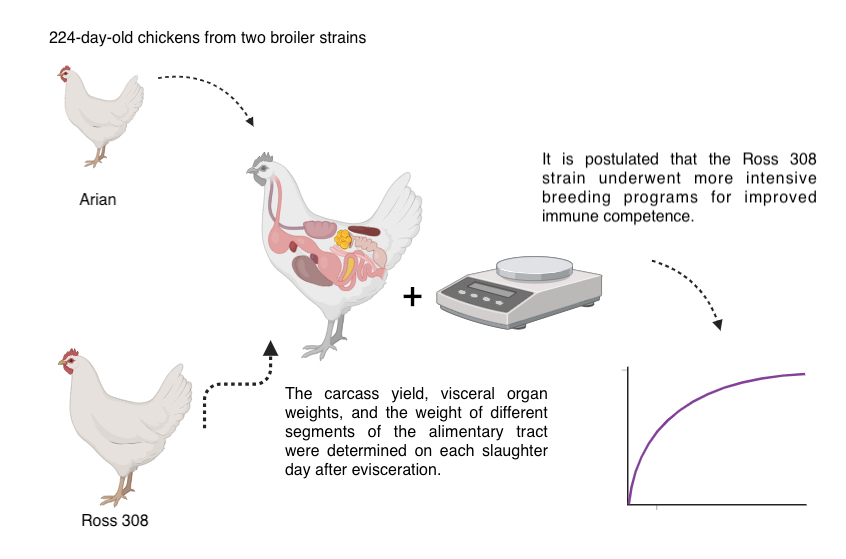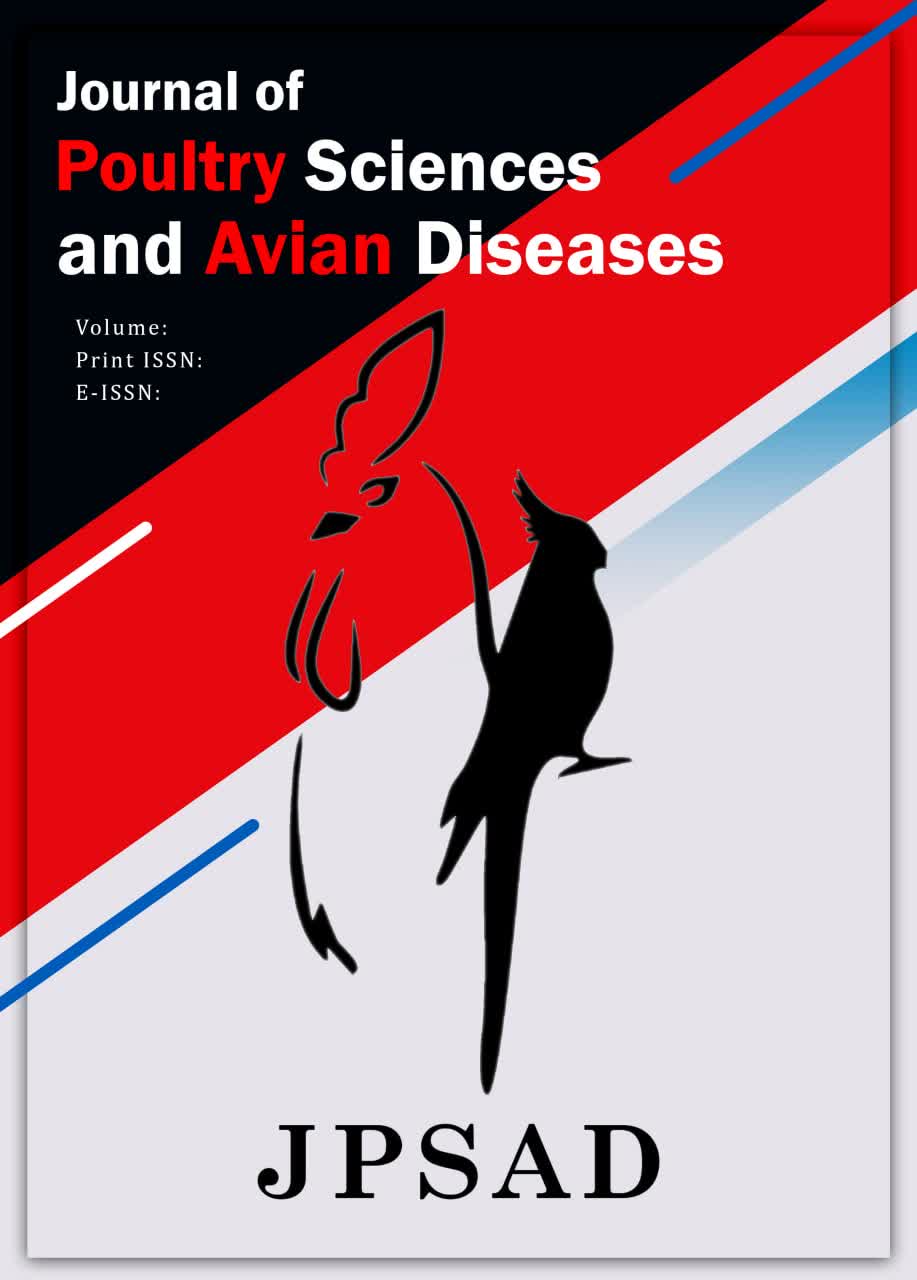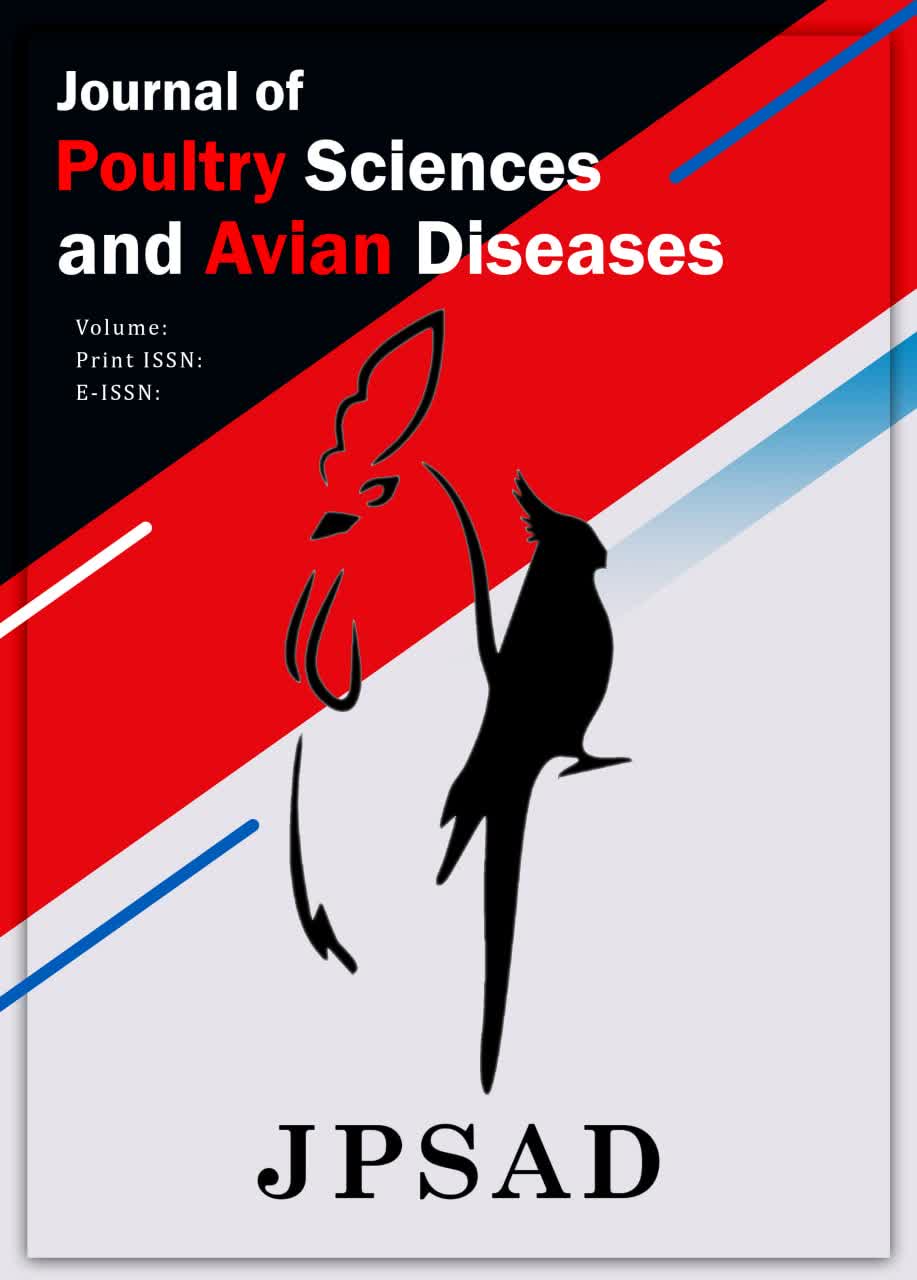Effect of Broiler Strain, Sex, and Age on the Live Body Weight and Relative Weights of the Visceral Organs in Broiler Chickens
Keywords:
Arian, Breeding, Carcass, Ross 308, Small intestineAbstract
The study examined the effect of age, strain, and gender on chickens' body weight, carcass yield, and relative weight of some visceral organs. A total of 224-day-old chickens from two broiler strains (Arian and Ross 308) were randomly allocated into 56 wire cages. Each cage contained four broilers (two males and two females), resulting in 28 replicate cages for each strain. On four specific days of the rearing period (days 10, 24, 32, and 42), 12±2 male and 12±2 female chickens from each broiler strain were randomly selected, weighed, and slaughtered. The carcass yield, visceral organ weights, and the weight of different segments of the alimentary tract were determined on each slaughter day after evisceration. The findings indicated that Ross 308 broilers were significantly heavier than Arian chickens at 32 and 42 days. The gizzard and jejunum relative weights in the Arian strain were significantly higher than in Ross 308 (p<0.05). Females in both strains had a higher relative liver weight compared with males. The bursa in the Ross 308 was found to be significantly heavier compared to Arian only in 32-day-old broiler chickens. Additionally, in 24-day-old chickens of the Ross strain, the weight of the bursa was heavier than that in 10-day-old chickens from the same strain (p<0.05). Therefore, due to enhanced bursa growth (10–24 days) and higher relative bursa weight in Ross 308 compared with Arian, it is postulated that the Ross 308 strain underwent more intensive breeding programs for improved immune competence.
Downloads
References
Huber K. Invited review: resource allocation mismatch as a pathway to disproportionate growth in farm animals - prerequisite for a disturbed health. Animal. 2018;12(3):528-36.
Rothschild D. A comparison of immune response and organ weights in broiler chickens: University of Guelph; 2019.
Grosso J, Balieiro JCC, Eler JP, Ferraz JBS, Mattos EC, Michelan Filho T. Estimates of genetic trend for carcass traits in a commercial broiler line. Genetics and Molecular Research. 2009;8(1):97-104.
Brake J, Havenstein GB, Scheideler SE, Ferket PR, Rives DV. Relationship of Sex, , age and body weight to broiler carcass yield and offol production. Poultry Science. 1993;72(6):1137-45.
Benyi K, Tshilate TS, Netshipale AJ, Mahlako KT. Effects of genotype and sex on the growth performance and carcass characteristics of broiler chickens. Tropical Animal Health and Production. 2015;47(7):1225-31.
Leeson S, Summers JD. Production and carcass charachteristics of the. Poultry Science. 1980;59(4):786-98.
Hurwitz S, Sklan D, Bartov I. New formal approches to the determination of energy and amino acid requirements of chicks. Poultry Science. 1978;57(1):197-205.
Krás R, Kessler AdM, Ribeiro A, Henn J, Bockor L, Sbrissia A. Effect of dietary fiber, genetic strain and age on the digestive metabolism of broiler chickens. Rev Bras Ciência Avícola. 2013;15(2):83-90.
Plavnik I, Hurwitz S. Organ weights and body composition in chickens as related to the energy and amino acid requirements: Effects of Strain, Sex, and Age. Poultry Science. 1983;62(1):152-63.
Fernandes JIM, Bortoluzzi C, Triques GE, Garcez Neto AF, Peiter DC. Effect of strain, sex and age on carcass parameters of broilers. Acta Scientiarum Animal Science. 2013;35(1).
Alshamy Z, Richardson KC, Hünigen H, Hafez HM, Plendl J, Al Masri S, et al. Comparison of the gastrointestinal tract of a dual-purpose to a broiler chicken line: A qualitative and quantitative macroscopic and microscopic study. PLoS One. 2018;13(10):e0204921.
Mabelebele M, Alabi OJ, Ng'ambi JW, Norris D, Ginindza MM. Comparison of gastrointestinal tracts and pH value of digestive organs of Ross 308 broiler and Indigenous Venda chickens fed the same diet. Asian Journal of Animal and Veterinary Advances. 2013;9(1):71-6.
Santos A, Sakomura N, Freitas E, Fortes C, Carrilho E. Comparison of free range broiler chicken strains raised in confined or semi-confined systems. Revista Brasileira de Ciência Avícola. 2005;7(2):85-92.
Zaefarian F, Abdollahi MR, Cowieson A, Ravindran V. Avian Liver: The Forgotten Organ. Animals. 2019;9(2):63.
Ojedapo LO, Akinokun O, Adedeji TA, Olayeni TB, Ameen SA, Ige AO. Evaluation of growth traits and short-term laying performance of three different strains of chickens in the Derived Savannah Zone of Nigeria. International Journal of Poultry Science. 2007;7(1):92-6.
Perozo-Marin F, Nava J, Mavárez Y, Arenas E, Briceno FSY. Morphometric characterization of Ross line broiler chickens' lymphoid organs reared under field conditions in Zulia state. Revista Científica de la Facultad de Ciencias Veterinarias. 2004;14(3):217-55.
Cazaban C, Majo Masferrer N, Dolz Pascual R, Nofrarias Espadamala M, Costa T, Gardin Y. Proposed bursa of fabricius weight to body weight ratio standard in commercial broilers. Poultry Science. 2015;94(9):2088-93.
Heckert RA, Estevez I, Russek-Cohen E, Pettit-Riley R. Effects of density and perch availability on the immune status of broilers. Poultry Science. 2002;81(4):451-7.
Cheema M, Qureshi M, Havenstein G. A comparison of the immune response of a 2001 commercial broiler with a 1957 randombred broiler strain when fed representative 1957 and 2001 broiler diets. Poultry Science. 2003;82(10):1519-29.
Dibner JJ, Richards JD. The digestive system: Challenges and opportunities. Journal of Applied Poultry Research. 2004;13(1):86-93.
Mobini B. Age-dependent morphometric changes of different parts of small and large intestines in the ross broilers. International Journal of Agro Veterinary and Medical Science. 2011;5(5):456.
Ankney CD, Afton AD. Bioenergetics of Breeding Northern Shovelers: Diet, Nutrient Reserves, Clutch Size, and Incubation. Condor. 1988;90(2):459-72.
Clench MH. The avian cecum: Update and motility review. J Exp Zool. 1999;283(4-5):441-7.
Mabelebele M, Norris D, Brown D, Ginindza MM, Ngambi J. Breed and sex differences in the gross anatomy, digesta pH and histopathology of the gastrointestina tract of Gallus gallus domesticus. Revista Brasileira de Ciência Avícola. 2017;19(2):339-46.
de Verdal H, Mignon-Grasteau S, Jeulin C, Le Bihan-Duval E, Leconte M, Mallet S. Digestive tract measurements and histological adaptation in broiler lines divergently selected for digestive efficiency. Poultryence Sci. 2010;89(9):1955-61.
Daghir NJ, Pellett PL. Influence of breed, age, and body weight on organ weight in the chicken 1. British Poultry Science. 1967;8(3):183-91.
Crompton DWT, Walters DE. A study of the growth of the alimentary tract of the young cockerel. British Poultry Science. 1979;20(2):149-58.
Al-Dabagh MA, Abdulla M. Correlation of sizes and weights of livers and spleens to the ages and body weights of normal chicks with a note on the histology of these organs in chicks. Veterinary Record. 1963;75:397-400.
Susbilla JP, Frankel TL, Parkinson G, Gow CB. Weight of internal organs and carcase yield of early food restricted broilers. British Poultry Science. 1994;35(5):677-85.
Martínez Y, Altamirano E, Ortega V, Paz P, Valdivié M. Effect of age on the immune and visceral organ weights and cecal traits in modern broilers. Animals. 2021;11(3):845.
Philipsen M, Dueholm J, Jørgensen A, Escalera S, Moeslund T. Organ segmentation in poultry viscera using RGB-D. Sensors. 2018;18(1):117.
Huang Sc, Fu YF, Rehman MU, Li K, Lan Yf, Liu W. Effect of the acute heat stress on serum endotoxin concentration and the expression of TLR4 mRNA in liver of Arbor Acres broiler chickens. Animal Production Science. 2018;58(12):2200.
Senanayake S, Ranasinghe JGS, Waduge R, Nizanantha K, Alexander P. Changes in the serum enzyme levels and liver lesions of broiler birds reared under different management conditions. Tropical Agricultural Research. 2015;26(4):584.
Zhang P, Shi B, Li T, Xu Y, Jin X, Guo X. Immunomodulatory effect of Artemisia argyi polysaccharide on peripheral blood leucocyte of broiler chickens. Journal of Animal Physioloy and Animal Nutrition (Berl). 2018;102(4):939-46.
Tambini AA, Perales CR, Alba CM, Falcón PN. Anatomical and histopathological evaluation of the bursa, thymus and spleen of broiler chickens raised in new or reused litter. Revista de Investigaciones Veterinarias del Perú. 2012;21(2).
Xu TS, Liu XL, Huang W, Hou SS. Estimates of genetic parameters for body weight and carcass composition in Pekin Ducks. Journal of Animal and Veterinary Advances. 2011;10(1):23-8.
Ohtsu H, Yamazaki M, Abe H, Murakami H, Toyomizu M. Heat stress modulates cytokine gene expression in the spleen of broiler chickens. Journal of Poultry Science. 2015;52(4):282-7.
Cheema MA, Qureshi MA, Havenstein GB. A comparison of the immune profile of commercial broiler strains when raised on marginal and high protein diets. International Journal of Poultry Science. 2003;2(5):300-12.
Khajavi M, Rahimi S, Hassan ZM, Kamali MA, Mousavi T. Effect of feed restriction early in life on humoral and cellular immunity of two commercial broiler strains under heat stress conditions. British Poultry Science. 2003;44(3):490-7.

Downloads
Published
Issue
Section
License
Copyright (c) 2024 Farhad Samadian (Corresponding Author); Razieh Ahmadzadeh, Javad Habibizad, Mostafa Mohaghegh-Dolatabadi, Alireza Eivakpour (Author)

This work is licensed under a Creative Commons Attribution-NonCommercial 4.0 International License.

















